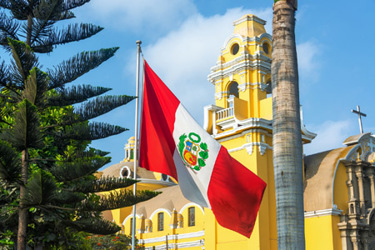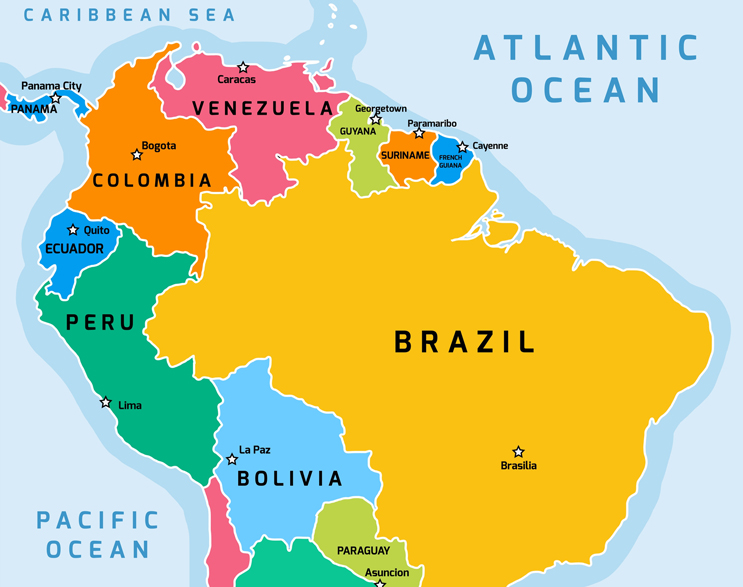Peru's Growing Medical Device Market In Latin America
By Julio G. Martinez-Clark, CEO, bioaccess

With a population of 32 million, Peru is the fifth most populous country in Latin America after Brazil, Mexico, Colombia, and Argentina. It has one of the highest average life expectancies of the region (77 years)1,2 and a gross domestic product (GDP) of $203.7 billion, making it the fifth largest economy in Latin America after Brazil, Mexico, Argentina, and Colombia.3,4 The size of the Peruvian medical device market is $390 million, and Peru imports more than 97 percent of the medical devices that it uses.5
This article discusses why, despite the pandemic's effects on Peru's health and economy, the country offers business opportunities for foreign manufacturers of medical devices. I will cover the country's health system, its regulatory framework, opportunities for medical device imports, and an outlook of doing business in the country going forward.
Peru’s Health System
The Peruvian health system has five main entities:
- The Ministry of Health (MINSA), the leading healthcare provider financed with public funds, which serves 60 percent of the population through a network of public hospitals and clinics and offers comprehensive health insurance (SIS);
- Es Salud, the national social security agency, funded by payroll taxes, which provides services to 30 percent of Peruvians and a special regime that serves the remaining 10 percent of the population;
- The armed forces;
- The national police; and
- The private sector.6
The National Health Superintendence acts as the supervisory and regulatory body for Peru's health system. Health services have improved as Peru has developed rapidly over the past two decades; however, a disparity in coverage persists between Lima and the rural Andean and Amazon regions of the country.7 In recent years, Es Salud has opened two hospitals with a public-private partnership (PPP) and will continue to tender new hospitals under this model.8
Government spending before the COVID-19 pandemic reflects Peru's attempts to develop the health sector. Peru's budget for 2019 included $5.4 billion for the industry, an increase of 14 percent from the $4.8 billion allocated in 2018. These amounts have been insufficient despite the resources allocated, as the health sector remains under-resourced.9 Peru has one of the lowest health budgets in South America; the average investment in health is only 4 percent of GDP, compared to an average of 8 percent in the countries belonging to the OECD.10
Unlike other countries in the region, such as Chile and Colombia, the fragmented health system in Peru hinders the coordinated implementation of public health policies. The current COVID-19 pandemic has exposed the severe deficiencies of the Peruvian health system, which was completely overwhelmed in its capacity to respond.9 The World Health Organization (WHO) recommends 45 health workers for every 10,000 inhabitants; Peru has 32 for every 10,000 inhabitants. Despite this, there is a very high concentration of medical specialists in urban areas, especially Lima.11 Peru has about one doctor for every 390 inhabitants and one nurse for every 368 inhabitants; there are only two intensive care unit beds for every 100,000 inhabitants and 700 intensive care doctors. According to MINSA, the deficit of medical specialists throughout the country is significant. In June 2020, the installed capacity of intensive care beds had increased by 2,000 since the start of the COVID-19 pandemic; Peru is now removing temporary beds from service as the number of cases decreases.12

Accessing Peru’s Medical Device Market
In Peru, law 29459 of November 2009 (Law of Pharmaceutical Products, Medical Devices, and Health Products) establishes the regulatory framework for the medical industry. Law 29459 specifies the document requirements, application evaluation timelines, and surveillance obligations to apply for market clearance (aka "sanitary registration") for pharmaceuticals, medical devices, and other health products. The law also incorporates specific chapters on access to rational use of medical products and includes a chapter on clinical research.13
In 2011, Peru incorporated the classification of medical devices and in-vitro diagnostics products into its regulatory framework based on risk levels. Peru classifies medical devices as follows:13
- Class I: Low risk, subject to general controls.
- Class II: Moderate risk, special controls in the manufacturing phase.
- Class III: High risk, special controls in design and manufacturing.
- Class IV: Critical in terms of risk, special controls in the design and throughout the manufacturing process to demonstrate its safety and efficacy.
Peru is the fourth recipient of foreign direct investment (FDI) in Latin America after Brazil, Colombia, and Chile, thanks to its attractive legislative and fiscal framework and dynamic industries.14 Foreign manufacturers require a sanitary registration to import, market, and sell medical equipment and devices in Peru. The General Directorate of Medicines, Supplies, and Drugs (DIGEMID) is Peru's regulatory agency and is part of MINSA. It is mandatory to name a local importer or distributor as the company-owner of the sanitary registration certificate for medical devices. DIGIMED does not allow foreign manufacturers to be the owners of sanitary registrations.
Peruvian public and private hospitals purchase new medical equipment; used medical equipment is only allowed for individual physicians who buy it for personal use.5,15 DIGEMID evaluates the applications for registration and re-registration of medical devices, with the amount of time required for such evaluations varying according to each risk level: Class I (low risk): up to 60 calendar days; Class II (moderate risk): up to 90 calendar days; Class III (high risk): up to 120 calendar days; and Class IV (critical risk): up to 120 calendar days.
DIGIMED's evaluation period is up to 30 calendar days when the European Medicines Agency (EMA) has approved the product, WHO has prequalified it, or approval has occurred in reference countries with high health surveillance: France, Holland, the United Kingdom, the United States, Canada, Japan, Switzerland, Germany, Spain, Australia, Denmark, Italy, Norway, Belgium, Sweden, the Republic of Korea, Portugal, Ireland, and Hungary. The DIGEMID registration fees range from $450 to $650, depending on the device's risk classification.16
Under the United States-Peru Free Trade Agreement (PTPA), medical devices, medical equipment, and pharmaceutical products enter Peru duty-free. Foreign manufacturers selling in the U.S. need to provide an FDA Certificate to Foreign Government (CFG) to DIGIMED and the customs agency in Peru to take advantage of duty-free imports.5 U.S. companies must register their products in Peru with a local distributor or importer registered through DIGEMID.15
Opportunities For Medical Device Companies
Working with a local distributor is advantageous because Peruvian customers and potential buyers prefer to buy locally from someone who can provide after-sales services. U.S. manufacturers must maintain close contact with end users and provide training and demonstrations so they can become familiar with the equipment.5
In recent years, Peru has made some progress in improving its health infrastructure, expanding access to care, and modernizing public institutions, with the stated goal of universal coverage by 2021 and 2022. Peru has a pressing need for newer health facilities and trained personnel to improve the equity of health outcomes in rural areas and underserved areas in large urban centers. Peru needs mobile and temporary clinics, ventilators, oxygen, drugs for specialized treatments, and personal protective equipment to address the ongoing COVID-19 pandemic and possible future outbreaks.5
Peru's growing middle class is increasingly turning to the private sector for healthcare and has higher expectations of healthcare providers. Approximately 2 million people are 65 years of age or older, and demand for quality care and treatment for older people and people with cancer, cardiovascular disease, and diabetes is increasing. In stark contrast to the public system, the private health sector has been particularly dynamic, having experienced significant growth in the past five years, driven by rising insurance penetration rates. Private investment in the industry has reached $400 million, with the addition of approximately 1,100 remote intensive care unit (ICU) hospital beds.5,15
The Peruvian government's interest in improving the country's health system and private companies' interest in investing more in specialized equipment will create opportunities for foreign manufacturers of medical devices. Local manufacturing is limited to consumables, essential electrodiagnosis, and hospital furniture.
A new national cancer law created differentiated mechanisms to acquire pharmaceutical products, medical devices, and health services necessary to treat oncological diseases. Therefore, an excellent opportunity is unfolding for the oncology medical device industry.17
Digitization and telemedicine, or telehealth, are also priorities for the Peruvian health sector. In 2019, MINSA approved a new telehealth framework to promote the modernization of health benefits through information and communication technologies (ICTs). The framework aims to bring all health institutions, private and public, under standardized rules and allow health professionals to receive information remotely. There are currently 2,441 health establishments incorporated into the National Telehealth Network of Peru; these provide telehealth services, tele-management, remote dissemination of information, education, and training to promote healthy lifestyles and strengthen the capacities of health personnel.18
The Association of Pharmaceutical Laboratories of Peru (ALAFARPE) points out that electronic prescription systems and electronic medical records, among others, should also be adopted. Related implementation of appropriate standards for installation of technological infrastructure and training will also be necessary. The sector also needs to establish training strategies that strengthen the capacities of the professional personnel involved in the subject of medical devices.19
Looking Forward
Peru has registered sustained GDP growth and low inflation in the last 20 years, sometimes surpassing global and regional averages. Following the impact of COVID-19, top multilateral institutions estimate that in 2021 and 2022, Peru will register the highest growth rate in South America and that in 2023 it will register the second-highest growth rate.14 Peru is a country that generates trust for foreign investors, as it continues to have one of the lowest country risks in the Latin American region despite political uncertainty during the recent change of government.
Although the growth of the Peruvian medical device sector was modest in 2021, Peru could become an attractive destination due to the provisioning needs of the national hospital network (especially in telemedicine) and the health needs of its aging population. Peru's lack of infrastructure in rural hospitals, the start of the PPP model, and the national need to invest more in specialized equipment will generate opportunities for foreign manufacturers of medical devices since Peru traditionally imports almost all the medical devices it needs.
On January 25, 2022, the OECD decided to open membership discussions with Peru. Since 2018, Peru has been implementing an action plan to join the OECD (Chile, Costa Rica, Colombia, and Mexico are already OECD members). The action plan's review and evaluation procedure have allowed for sharing OECD standards and best practices with the Peruvian authorities. This work will improve Peru’s social and economic policies and create better public and private institutions. Peru is also a member of the Pacific Alliance, a regional trading bloc including Chile, Colombia, and Mexico. This sharing with the OECD and the Pacific Alliance has helped Peru identify areas for future reforms that are making the country a more internationally open, business-friendly, competitive, and productive economy in Latin America.19
References
- Population, total - Latin America & Caribbean. The World Bank. [Online] 2021. https://data.worldbank.org/indicator/SP.POP.TOTL?locations=ZJ&most_recent_value_desc=true.
- Life expectancy at birth, total (years) - Latin America & Caribbean. The World Bank. [Online] 2021. https://data.worldbank.org/indicator/sp.dyn.le00.in?locations=ZJ&most_recent_value_desc=true.
- Gross domestic product (GDP) in Latin America and the Caribbean in 2020, by country(in billion U.S. dollars). Statista. [Online] 2021. https://www.statista.com/statistics/802640/gross-domestic-product-gdp-latin-america-caribbean-country/.
- Gross domestic product (GDP) per capita in Latin America and the Caribbean in 2020, by country (in U.S. dollars). Statista. [Online] 2020. https://www.statista.com/statistics/802613/gross-domestic-product-gdp-per-capita-latin-america-caribbean/.
- Peru - Country Commercial Guide. International trade administration. [Online] 2021. https://www.trade.gov/country-commercial-guides/peru-medical-devices.
- World Health Organization. Global Health Workforce Alliance. Peru. [Online] 2021. https://www.who.int/workforcealliance/countries/per/en/.
- RECURSOS HUMANOS EN. SALUD AL 2011. Evidencias para la toma de decisiones. MINSA. [Online] 2011. https://www.minsa.gob.pe/dggdrh/libros/pdf/s1/I-14.%20Recursos%20Humanos%20en%20Salud%2027.06.11.pdf.
- Asociación Público Privada-Contratos Vigentes. Seguro Social de Salud. [Online] https://www.essalud.gob.pe/asociacion-publico-privada-contratos-vigentes/.
- Menos del 27% del presupuesto del sector salud se utiliza para el cierre de brechas: ¿qué hay detrás de la lenta ejecución? El Comercio. [Online] October 23, 2021. https://elcomercio.pe/economia/salud-menos-del-27-del-presupuesto-del-sector-se-utiliza-para-el-cierre-de-brechas-que-hay-detras-de-la-lenta-ejecucion-covid-19-ministerio-de-salud-minsa-ministerio-de-economia-y-finanzas-mef-gasto-publico-coronavirus-notic.
- HEALTH FINANCING IN THE AMERICAS. Pan American Health Organization (PAHO). [Online] https://www.paho.org/salud-en-las-americas-2017/uh-financing.html#:~:text=The%20strategy%20for%20universal%20access,a%20necessary%2C%20
though%20insufficient%2C%20factor. - Minsa: Faltan incorporar más de 11,000 médicos especialistas en todo el país. GESTIÓN. [Online] February 23, 2020. https://gestion.pe/economia/minsa-solo-una-region-del-peru-supera-el-nivel-de-enfermeros-recomendados-por-la-oms-y-no-es-lima-noticia/.
- Sin respiro: Unidades de Cuidados Intensivos necesitan 700 médicos. Salud con lupa. [Online] April 9, 2020. https://saludconlupa.com/entrevistas/sin-respiro-unidades-de-cuidados-intensivos-necesitan-700-medicos/.
- LEY N.º 29459 - SciELO Perú. SCIELO. [Online] 2009. https://www.scielo.org.pe/pdf/rins/v26n4/a14v26n4.pdf.
- Why invest in Peru: key reasons to explore untapped opportunities. Reuters. [Online] February 2, 2022. https://www.reuters.com/article/sponsored/why-invest-in-peru-key-reasons-to-explore-untapped-opportunities.
- World Health Organization (WHO). [Online] https://www.who.int/medical_devices/Sat_pm_REG_2_PINEDO.pdf?ua=1.
- Decreto Supremo que aprueba el Reglamento para el Registro Sanitario Condicional de Medicamentos y Productos Biológicos. El Peruano. [Online] 2021. https://busquedas.elperuano.pe/normaslegales/decreto-supremo-que-aprueba-el-reglamento-para-el-registro-s-decreto-supremo-n-002-2021-sa-1918580-1/.
- LEY NACIONAL DEL CÁNCER, LEY 31336. Congreso de la República del Perú. Archivo Digital de la Legislación del Perú. [Online] August 10, 2021. [Cited: March 24, 2022.] https://leyes.congreso.gob.pe/Documentos/2016_2021/ADLP/Texto_Consolidado/31336-TXM.pdf.
- Plataforma de Red Nacional de Telesalud la integran 2,441 instituciones. El Peruano. [Online] January 31, 2021. [Cited: March 24, 2022.] https://elperuano.pe/noticia/114443-plataforma-de-red-nacional-de-telesalud-la-integran-2441-instituciones.
- The OECD and Peru: A mutually beneficial relationship. OECD. [Online] [Cited: March 24, 2022.] https://www.oecd.org/latin-america/countries/peru/
About The Author:
 Julio G. Martinez-Clark is co-founder and CEO of bioaccess, a market access consultancy that works with medical device companies to help them do early-feasibility clinical trials and commercialize their innovations in Latin America. Julio is also the host of the LATAM Medtech Leaders podcast: A weekly conversation with Medtech leaders who have succeeded in Latin America. He serves as an advisory board member for Stetson University's Leading Disruptive Innovation program. He has a bachelor's degree in electronics engineering and a master's degree in business administration.
Julio G. Martinez-Clark is co-founder and CEO of bioaccess, a market access consultancy that works with medical device companies to help them do early-feasibility clinical trials and commercialize their innovations in Latin America. Julio is also the host of the LATAM Medtech Leaders podcast: A weekly conversation with Medtech leaders who have succeeded in Latin America. He serves as an advisory board member for Stetson University's Leading Disruptive Innovation program. He has a bachelor's degree in electronics engineering and a master's degree in business administration.
